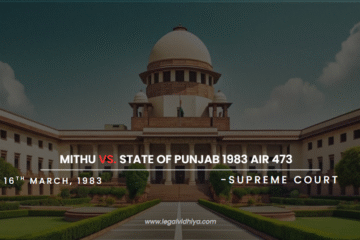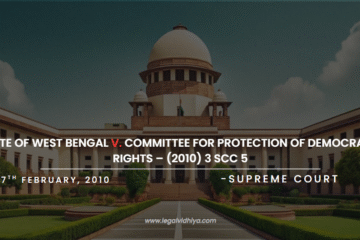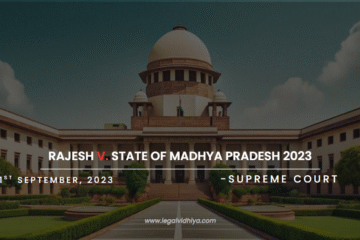
| CITATION | 1993 AIR 1960, 1993 SCR (2) 581 |
| DATE | 24 March, 1993. |
| COURT NAME | SUPREME COURT OF INDIA |
| PLAINTIFF/APPELLANT/PETITIONER | Smt. Nilabati Behera alias Lalit/Lalith(Petitioner) |
| DEFENDANT/RESPONDENT. | State of Orissa and Orissa Police Officials |
| JUDGES | Justice J.S. VermaJustice Dr. A.S. AnandJustice N.P. Singh |
INTRODUCTION
This case reinforced the right to life under Article 21 and established judicial recognition of compensation as a public law remedy for custodial death. In this instance, Nilabati Behera, the mother of the young man who passed away, filed a petition with the Supreme Court of India requesting a writ, claiming that the police used excessive force which led to her son’s death.. Custodial death was the term used to describe the death. After reviewing her letter as a writ petition, the Supreme Court awarded her damages for her son’s death while in her care.
FACTS OF THE CASE
- Suman Behera, aged 22 and hailing from Odisha, was apprehended by authorities at the Jeraikela Police Outpost in the Sundergarh district on December 16, 1987.He was suspected of theft. However, no formal arrest occurred, no FIR was filed, and he was not brought before a magistrate after his detention. His detention was illegal from the start.
- The next morning, December 17, his lifeless body was found near a train track, close to the police outpost. The body had many visible wounds, including cuts and bruises. The post-mortem examination confirmed blunt force injuries and clearly showed that he had been beaten while still alive.
- The police claim that he was killed by a train while allegedly attempting to flee was refuted by these injuries.
Nilabati Behera, his mother, petitioned the Supreme Court under Article 32. She alleges that her son’s right to life under Article 21 of the Constitution was infringed when he died as a result of police abuse while being held in custody. She wanted restitution for the death that occurred while she was incarcerated. All charges were refuted by the State of Orissa. According to the story, Suman died in a railroad accident after escaping. The severity of the injuries, the incorrect arrest process, and the reason no legal action was taken while he was in jail were not mentioned, nevertheless. - A key legal issue raised by this case was whether constitutional courts have the authority to compensate for the violation of fundamental rights right away, especially when there has been a custodial death.
ISSUES OF THE CASE
- The Issue raised by the Petitioner in this case was whether there is a right to life under Article-21 of the Indian constitution,and whether the supreme court of india and the high courts can issue monetary compensation in case of (or if it is given in compensation for) violation of fundamental right under Article-32 and 226 of Indian Constitution respectively, if the case with regard to “Sovereign Immunity.
JUDGEMENT
The State of Orissa, the Respondent, was ordered by the Supreme Court to reimburse Mrs.Nilabati Behera a sum of Rs. 150,000, in addition to Rs.10,000 to be given to the Supreme Court Legal Aid Committee.
It was argued that the substantiation presented during the inquiry doesn’t corroborate the repliers’ defense, and the conclusion of the learned District Judge that Suman Behera failed while in police guardianship due to injuries sustained shouldn’t be dismissed. rate decidendi( The principle of law upon which a judicial decision is innovated)- It’s apparent that there was no substantiation indicating that the police conducted any quests to seize Suman Behera if their claim of his being in police guardianship is accurate.
In contrast to the early morning discovery of the body on the railway track by some railway workers, the police did not arrive at the scene until much later in the day to take control of the body. The actions of the relevant law enforcement officials are also a significant factor in evaluating the reliability of the defense’s account. The doctor suggested that all the injuries might have resulted from lathi blows, even though not every one of them could have been the result of a train accident.
There exists a distinction between the liability of the state in public law and the liability of the state in camera law regarding compensation payment in related actions. According to Article 226 of the constitution, the compensation granted in any process under Article 32 by this court or by the state Supreme Court mayserve as a remedy under public law, which is based on strict liability for violations of fundamental rights, where the principle of exemption does not apply. Conversely, this may be used as a defense in camera law for actions based on tort.
The current court has the authority under Article 142, which also serves as an enabling provision in this context. Justice Dr. Anand expressed a Concurring Opinion stating that it is the government’s responsibility to ensure that individuals’ rights are upheld according to the law when they are in custody. The essential right protected by Article 21 of the Indian Constitution cannot be taken away from convicts, undertrials, or other detainees, except through legal procedures that have been established.
It is the police or prison authorities’ important duty to ensure that any citizen in their custody is not deprived of the right to life. The individual’s freedom, although limited by the reality of their confinement, holds significant value within the constraints of their remaining liberty. The state has an unqualified duty of care that does not allow for any exceptions. If an individual in police custody loses their life, the wrongdoing falls on the responsible party, making the state liable unless it follows the established legal procedures.
If anyone dies while in police custody, the state is held accountable for the crime and is held accountable until the proper legal procedures are followed.
This case strikes at the core of what justice ought to look like in a democratic nation, not just highlighting a legal principle. Beyond the usual procedures, the Court examined the actual suffering brought on by prison assault.It acknowledged that departmental investigation and prosecution alone are insufficient. The state cannot utilize justifications when someone passes away while in its care. It must be answerable, not only verbally but also by deeds and responsibility.
The Court’s unambiguous message—that basic rights cannot be suspended at the lock-up gate—stands out. This case further supported the notion that Article 32 is a genuine remedy that can result in monetary recompense, rather than just a hollow promise.
This ruling set a standard for subsequent custodial death cases and established the foundation for victim-centric justice, particularly in situations involving state excesses
REASONING
The Supreme Court substantially used the strict liability principle in cases of deaths being while a person was in guardianship. It ruled that when someone dies while in the state’s custody, the state must prove the cause of death. The Court stated that the state should be held more responsible because detained individualizes are in a vulnerable position and fully under the authority of the state. This is necessary to cover the introductory rights to life and particular liberty, as outlined in Composition 21 of the Indian Constitution.
The Court further stressed that government officers cannot escape violating abecedarian rights by claiming autonomous impunity. It refocused out that counting on tort remedies for restitutions isn’t enough in some cases. The Court honored this and decided that financial compensation could be handed as a public law remedy under Composition 32 or 226. It clarified that, in certain cases, compensation not only helps the victim or their family, but also serves as a warning against unborn abuses of state power. When it comes to holding the government responsible for indigenous violations, the Court stressed the need for quick and effective requital while admitting the limits of traditional judicial remedies.
CONCLUSION
The Supreme Court ruled that the state’s contempt for Suman Lal Behera’s life and freedom caused him to pass away while he was in custody. A substantial settlement was negotiated between the Court and Nilabati Behera.
. The decision also exposed grave abuses of human rights, including as torture and deaths in detention. It made it plain that protecting those under its care is the responsibility of the state. The court ordered the State of Odisha to give the plaintiff a specific sum and Rs 10,000 to the Supreme Court’s Legal Aid Committee. The compensation awarded in this instance served as a reminder of the importance of protecting fundamental rights.
This case set a significant precedent for compensating victims of fatalities that occur when an individual is in detention and deadly rights breaches. It emphasized strict liability for deaths that occur while under state guardianship and restated the state’s duty to defend the abecedarian rights of people under its care. The ruling marked a significant step in lowering custodial violence in India.
REFERENCES
- https://indiankanoon.org/doc/1628260/
- Jus Corpus – Journal By Tushar Dhara
- Case Summary – www.dhyeyalaw.in
Written by Vikas Sharma an Intern under Legal Vidhiya.
Disclaimer: The materials provided herein are intended solely for informational purposes. Accessing or using the site or materials does not establish an attorney-client relationship. The information presented on this site is not to be construed as legal or professional advice, and it should not be relied upon for such purposes or used as a substitute for advice from a licensed attorney in your state. Additionally, the viewpoint presented by the author is personal.
‘Social Media Head’ and ‘Case Analyst’ of Legal Vidhiya.




0 Comments